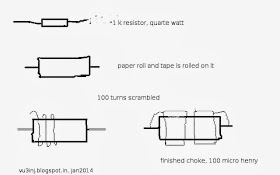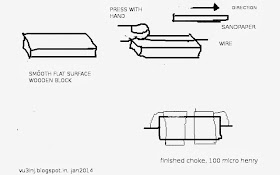During the re-inventing the wheel i came accoss one peculiar problem, so asked the groups. In this OM Charudutt -VU2UPX, OM SandeepLohia, VU2KD -OM sofi, OM Jishnu, OM Vaidyanathan Prv, OM Rajesh Kumar, OM Kaustav saha et al responded to my post.
The edited conversion was is as under. I hope it will be useful to future homebrewer and learn from my experience , understand the pitfalls and make a wise decesions.
(The transmitter write-up is here http://vu3inj.blogspot.in/2013/12/dsb-transmitter-xtal-14318kc.html )
It started like this:-
I have a trivial question to ask. When i drive the FET IRF510 on 20 meter band amp with 1.2 v gate bias and when i increase the gate bias voltage to abt 3 volts in between this region there is very high distortion. on first position dummy load become warm and receiver placed 10 feet apart likes the sound in second case the heatsink becomes the warm and dummy load becomes happy. receiver makes little difference in sound. In your opinion what bias voltage should be kept 1.2vdc or abt 3 volt. I also added that amp chain is being powered with 12v dc.
First reply came from Charudatt Uplap that Sandeep Lohia will surely be there to help.
Jishnu Nambissan also made a good point:-as far as I know , MOSFETs are unhappy to work in linear region ( increased heating ) ..... the transition from cutoff to saturation takes place around some 2 to 4 V (Plz refer data sheet) ... the MOSFET will be unhappy to work in this region ................
Vaidyanathan Prv advised not to talk in terms of (gate) voltage for biasing the FET IRF 510. When the device is used as a linear amplifier, set the bias in the gate to get 10- 15 ma in the drain( idle current) for push pull amp,and 50-60ma for single ended.therefore bias should not be referred to as gate voltage but only in terns of idle current Because no two units are similar we use separate pre set pots to bias the devices in push pull to get identical idle currents. IRF510, like the other power fETs is NOT intended for for linear duty.it is a switching device only. Linear operation is therefore, only compromise..so we have to tolerate the device for all mis behaviours..hi . (I think this is useful for the PUSH-PULL amp but we are talking here about the single ended PA... but he also has made a valid point on FET characteristic)
Sandeep Lohia :-I agree with Vaidyanathan Prv but again that is only suitable in case of close to 50 ohm proper load...
For U Indrajit I suggest : slowely increase gate voltage to a threshold, and stop just below where FET starts self-oscillating.
First tune your antenna & hombrew a RF probe... mis behaviour can be nulled somewhat using negativ feedback...
Try replacing IRF 510 with any other BJT-2SC1969, RD16HHF1 at your own risk.
(well i will not try other things as we want to use this fet only due to universal availabilty and cheap Rs17. The RD16HHF1 cost more)
Indrajit Sinh::- Thanks guys, i have put the IRF bias on first position and it gives me max clear rf output. ( This is the practical thing i wanted to know and this is what i have observed during the brewing.)
as said by lohia ji that is the point from where IRF starts misbehaving,,, let me also tell you that by increasing drain supply voltage (24vdc) to FET stage only POWER AND quality increased..... so thats it. i have re-invented the wheel ! EUREKA.....
As my first query was fully satisfied i put up the second query:- i have a question pa stage current remains constant at 22vdc around 550 ma as measured in the digital multimeter it is not showing increase as i speak ! it is ok .... or should i use the ameter (with dial). ( what i wanted to convery was the flicker of current , rise and fall of current sympathetic to voice peaks )
Answer came from Sandeep Lohia ? pa current constant not showing increase while speak/whistle??? Cheq ECM... No it not OK, this is what we call self-oscillation With 22 VDD output impedance 'Z' drop to approx 32 ohm... Here U need re-think 1:4 autotransformer , or simply use a 'PI' network @ output as used in tubes...
Md Sofi :-Dear Indrajit .In BITX linear board one jumper which is connected with IRF510 Drain,open the jumper placed the digital ammeter,apply the voltage regulated up to 30 volts DC.Set the current 30 mAmp help of 10K preset on board .Now connect the BITX exciter board to linear board,on the above condition you get more than 15 watts output.You never found any distortion in this case,if your drive signal is less and try to get more output by increasing volts at gate point it will heated up and distortion produced
Sandeep Lohia:- Sofi Sahab with 30 volt input & 15 watt RF we need 1:9 autotransformer (triflar) @ output, & not 1:4 as used in BITX...
Md Sofi :- in my case using SMPS 24V 5Amp power supply for linear only.
Indrajit Sinh :- Md Sofi ji has rightly pointed out the problem i was facing. there is no sufficient drive from driver stage. I am not using the bitx board. I am using the 22 vdc only. As pointed out by Lohia ji of impedance of transnformer is right.
I think i have reached with this design on a point where power can not be increased without further changes. So, i leave it as it is.
will try to change the xtal as suggested by lohiaji and put it on air and see how far it goes and all the effort was worth it or not. As it is a dsb tx only half of rf is useful. Will box it , make an external single ended FET840 amp driven by this whole dsb tx.i hope to upload few pics on blog for your observations.
Sandeep Lohia IRF840 has very high gate capacitance...For 20M not suitable
Indrajit Sinh ::-it means maximum platue in this project is achieved and only things remains is LPF, ATU and antenna side efforts.
I have further observed that the air core toroid design given by the VU2ESE OM Farhan in his first version of bitx tcvr is a very good one. It is usable for 5 watt level. In my ckt due to small size of wire SWG36 on high current it heats up. I have used the wire slavaged from CFL lamps transformer so insulation was good. Lohiaji suggested to use ferrite core when we are using more power. Power calculation for RF transformer is given in the RM-96 pdf. There push-pull amplifier set-up process is also given by VU2RM.
I wanted to make a small DSB transmitter using readily available xtal 14.318kc, which i have successfully made and hope that this will usefull to hams. At present there is no confirmed QSL report. If you make this please make it at your own risk. I have not designed any pcb. All parts are soldered on veroboards. Through mechanical stability was given importance. Nothing should be loose. Heatsink is slavaged from other commercial prduct.I am improvising it. Will make a first QSO and tell you. Originally this tx idea was taken from many other designs and this is the final ckt.I tried a bit and pieces from different design and whatever works for me was taken as mine.
Theoretically, same circuit can be used for 40 meter only change needs is tune amp and change of xtal. I hope to make a tuned amp for 40 meter and use it with 28.322kc and 14.318 kc xtal by dividing its frequency digitally and using the filters.so can be used for the two band.
Please note this tx runs on the 14316kc.
Thats it folks wheels have been re-invented. Enjoy.































